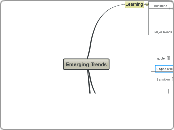Emerging Trends
Learning
Quote
Problems with traditional learning
Distance Learning is not new
Enrollment trends
schools going online
students learning online
students shopping for courses that fit their schedule and circumstances
older students are learning
adult learners are the fastest-growing population in higher education
40% increase every year
Academic trends
Knowledge and information are growing exponentially.
traditional campuses declining
Instruction is becoming more learner-centered, non-linear, and self-directed.
massive pedagogical shift
Academic emphasis is shifting from course-completion to competency.
Economic Trends
recession
funding for IT
Technology
mobile learning
virtual simulations
Second Life
Adaptive Learning Environments
Technological devices are becoming more versatile and ubiquitous
There is a huge growth in Internet usage.
Business
more tolerance for online degrees
view online courses are modern and competent
Major Trends
Companies integrate e-learning into their infrastructure.
Churning skill sets require e-learning initiatives.
E-Learning levels professional playing field around the world.
Gamers bring interactive skills to e-learning
Governments deploy e-learning at all levels
Partners and collaborators use e-learning to get everyone on the same page sooner.
Language
quote
2 types of learning
Formal
Informa
transition
tools
computer
cell
mp3
software
messengers
video-conference
interactive whiteboards
hire tutors online
native speaker
statistics
more students enrolled than ever before
what languages?
204 lesser taught languages
does online learning save you money?
benefits of virtual learning
